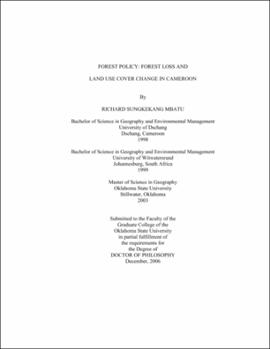| dc.contributor.advisor | Lewis, David | |
| dc.contributor.author | Mbatu, Richard Sungkekang | |
| dc.date.accessioned | 2013-11-26T08:29:50Z | |
| dc.date.available | 2013-11-26T08:29:50Z | |
| dc.date.issued | 2006-12 | |
| dc.identifier.uri | https://hdl.handle.net/11244/7111 | |
| dc.description.abstract | Scope and Method of Study: The purpose of this study was to analyze Cameroon's colonial and domestic forest policies and show how these policies have led to forest loss in Cameroon, determine their consequences on the environment, society and the economy, and develop policies to conserve the forest. The study is divided in three main sections. In the first section, a remote sensing model is combined with an economic model to measure the rate and degree of forest loss in Cameroon over a sixteen years period (1984-2000), and to identify the forces behind this loss. In the second section, changes in land use and forest cover are correlated with colonial and domestic policies. In the final section, a public policy analysis method (Multi-Goal Analysis) is used to develop/propose policies to manage and conserve the forest. | |
| dc.description.abstract | Findings and Conclusions: The remote sensing model indicated that 20.67% of the total territory of the study areas had changed in 16 year (1984 to 2000). Noticeable are changes (increase and decrease respectively) in Agricultural Field and Forest Land (33.42 and 31.54 Km^2 or 7.51% and 7.09% in area respectively). Within this time period, Agricultural Field changed at a rate of 2.09 Km^2/yr or 1.29% while Forest Land changed at a rate of 1.97 Km^2/yr or 0.87%. The economic models showed decrease in forest lands as the second most significant change on the landscape with increase in agricultural fields showing the most significant change. Modeling this change, panel analysis showed that decrease in forest lands is associated with increase in rural population and low income per capita (R^2 = 0.9892). Mathematically, by the year 2020 a total of 34.74 Km^2 of forest land in the two study areas will be lost to agricultural and urban/rural expansion or simply left as "open fields" prone to different forms of degradation. If such a loss occurs in the entire forest region of Cameroon, it is possible for the nation to lose more than half of its 22 million hectares of rain forest by 2050. Of the seven policy options proposed to reverse this trend, the option of reducing externalities in the forest sector through price mechanism and police power is the most efficient based on policy legitimacy criteria. | |
| dc.format | application/pdf | |
| dc.language | en_US | |
| dc.rights | Copyright is held by the author who has granted the Oklahoma State University Library the non-exclusive right to share this material in its institutional repository. Contact Digital Library Services at lib-dls@okstate.edu or 405-744-9161 for the permission policy on the use, reproduction or distribution of this material. | |
| dc.title | Forest policy: Forest loss and land use cover change in Cameroon | |
| dc.contributor.committeeMember | Lightfoot, Dale | |
| dc.contributor.committeeMember | Rao, Mahesh | |
| dc.contributor.committeeMember | Stoecker, Arthur | |
| osu.filename | Mbatu_okstate_0664D_2039.pdf | |
| osu.accesstype | Open Access | |
| dc.type.genre | Dissertation | |
| dc.type.material | Text | |
| thesis.degree.discipline | Environmental Science | |
| thesis.degree.grantor | Oklahoma State University | |
